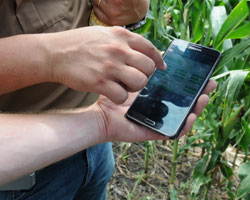Agricultural mobile apps provide in-the-field support for producers
A K-State crop production specialist compiled a list of apps that can benefit farmers and ranchers in a variety of ways.
 Released: March 30, 2016
Released: March 30, 2016
MANHATTAN, Kan. – As new technologies become more integrated into agricultural production, it becomes more important than ever for farmers and ranchers to have access to supportive information about these technologies. Ignacio Ciampitti, assistant professor in Kansas State University’s Department of Agronomy, began compiling lists of agricultural mobile applications that can be useful for producers and has made the lists available to the public through weekly eUpdates released through K-State Agronomy Extension.
Ciampitti, a K-State Research and Extension crop production and technology specialist, said the goal of the updates is to provide a summary of different agricultural apps that can help make production more efficient.
When looking for apps that will cover producers’ needs, there are some basic guidelines to follow. To begin, apps should be free to download, with the chance to pay for a premium version if the free trial works well.
“Once I feel comfortable with the application and what it has to offer, then I could recommend paying for the service,” Ciampitti said. “But first, you need to see if the app is worth it for you – if it can help you in your operations – and then, if there is a ‘pro’ version, pay for that.”
Ciampitti said he primarily tries to include free apps in the weekly eUpdates. It is also important that the apps be easy to use and intuitive, since they generally don’t come with a manual or guide.
“Once you download the app into your phone or tablet, take a look at the app, and if you don’t figure it out in few minutes, then it’s not worth your time,” Ciampitti said. “You should then just keep exploring for other potential mobile alternatives.”
Categories of apps
Ciampitti’s eUpdates are divided into categories, with 10 total to be published in the series. The first category is identification apps, which can help producers identify weeds, diseases, insects and nutrient needs in crop fields.
The second update focuses on calculator apps that are primarily used for calculations related to planting, spraying, fertilizing, harvesting and estimating yields.
The third update covers scouting apps that are used for scouting purposes or soil sampling, recording notes and soil types, and other geopositioning-related tasks.
The fourth classification, economic apps, covers applications primarily used for checking grain prices, market evolutions, fertilizer price trends, news and finances.
The fifth update covers field guide apps that help determine crop production issues while in the field, including information that would commonly be covered in crop management field guides.
The sixth update covers livestock apps and offers resources on animal nutrition, health and market information.
The seventh update covers apps related to crop irrigation and water application.
An update on machinery apps is meant to assist with items such as agricultural equipment preparation and inventory.
Finally, an update on general agricultural apps followed by non-agricultural apps should become available on April 1 and 8, respectively.
Other factors to consider
If producers are concerned about paying for an app or any of its functions, they should ask a friend, colleague or a specialist familiar with it for details, Ciampitti said.
“You’ll probably find apps that are similar, and it might be personal preference to decide which one of the apps you feel comfortable with,” he said. “Most of the time we are just identifying (apps producers can use), so make sure that you always go back to your extension agent or agronomist for more information.”
One key difference in apps from all classifications is whether they come with information and images pre-loaded, or if they connect to the Internet to give the user access to the most updated information available, which can create limitations when working in the field away from cellular service, according to Ciampitti.
“Some of the apps already have images,” Ciampitti said. “Those don’t need an Internet connection; the images are loaded when you are downloading the app. You are downloading the entire package.”
Apps that come with all their information pre-loaded are constrained by not being able to update independently, he added.
“The beauty of (Internet-connected) apps is that you can check the app every day, and you will find different information,” Ciampitti said. “It is a constraint on the other apps that you will always find the same information unless there is an update coming from the company or university.”
Overall, Ciampitti said he thinks both types of apps have certain roles to play. For more information on agricultural apps, visit the K-State Agronomy Extension eUpdate website.
-30-
K-State Research and Extension is a short name for the Kansas State University Agricultural Experiment Station and Cooperative Extension Service, a program designed to generate and distribute useful knowledge for the well-being of Kansans. Supported by county, state, federal and private funds, the program has county Extension offices, experiment fields, area Extension offices and regional research centers statewide. Its headquarters is on the K-State campus, Manhattan.
Story by:
Chloe Creager
K-State Research and Extension
ccreager@ksu.edu
For more information:
Ignacio Ciampitti- 785-532-6940 or ciampitti@ksu.edu
